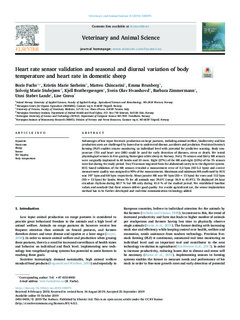| dc.contributor.author | Fuchs, Boris | |
| dc.contributor.author | Sørheim, Kristin | |
| dc.contributor.author | Chincarini, Matteo | |
| dc.contributor.author | Brunberg, Emma | |
| dc.contributor.author | Stubsjøen, Solveig Marie | |
| dc.contributor.author | Bratbergsengen, Kjell | |
| dc.contributor.author | Hvasshovd, Svein-Olaf | |
| dc.contributor.author | Zimmermann, Barbara | |
| dc.contributor.author | Lande, Unni Støbet | |
| dc.contributor.author | Grøva, Lise | |
| dc.date.accessioned | 2020-02-17T12:12:53Z | |
| dc.date.available | 2020-02-17T12:12:53Z | |
| dc.date.created | 2019-12-03T18:39:46Z | |
| dc.date.issued | 2019 | |
| dc.identifier.citation | Veterinary and Animal Science. 2019, 8 1-9. | |
| dc.identifier.issn | 2451-943X | |
| dc.identifier.uri | http://hdl.handle.net/11250/2641963 | |
| dc.description.abstract | Advantages of low input livestock production on large pastures, including animal welfare, biodiversity and low production costs are challenged by losses due to undetected disease, accidents and predation. Precision livestock farming (PLF) enables remote monitoring on individual level with potential for predictive warning. Body temperature (Tb) and heart rate (HR) could be used for early detection of diseases, stress or death. We tested physiological sensors in free-grazing Norwegian white sheep in Norway. Forty Tb sensors and thirty HR sensors were surgically implanted in 40 lambs and 10 ewes. Eight (27%) of the HR and eight (20%) of the Tb sensors were lost during the study period. Two Tb sensors migrated from the abdominal cavity in to the digestive system. ECG based validation of the HR sensors revealed a measurement error of 0.2 bpm (SD 5.2 bpm) and correct measurement quality was assigned in 90% of the measurements. Maximum and minimum HR confirmed by ECG was 197 bpm and 68 bpm respectively. Mean passive HR was 90 bpm (SD=13 bpm) for ewes and 112 bpm (SD=13 bpm) for lambs. Mean Tb for all animals was 39.6°C (range 36.9 to 41.8°C). Tb displayed 24-hour circadian rhythms during 80.7 % but HR only during 41.0 % of the studied period. We established baseline values and conclude that these sensors deliver good quality. For a wide agricultural use, the sensor implantation method has to be further developed and real-time communication technology added. | |
| dc.language.iso | eng | |
| dc.title | Heart rate sensor validation and seasonal and diurnal variation of body temperature and heart rate in domestic sheep | |
| dc.type | Peer reviewed | |
| dc.type | Journal article | |
| dc.description.version | publishedVersion | |
| dc.source.pagenumber | 1-9 | |
| dc.source.volume | 8 | |
| dc.source.journal | Veterinary and Animal Science | |
| dc.identifier.doi | 10.1016/j.vas.2019.100075 | |
| dc.identifier.cristin | 1756268 | |
| dc.relation.project | Regionale forskningsfond Innlandet: 248077 | |
| dc.relation.project | Regionale forskningsfond Midt-Norge: 248077 | |
| cristin.unitcode | 209,2,3,0 | |
| cristin.unitname | Institutt for skog- og utmarksfag | |
| cristin.ispublished | true | |
| cristin.fulltext | original | |
| cristin.qualitycode | 1 | |
